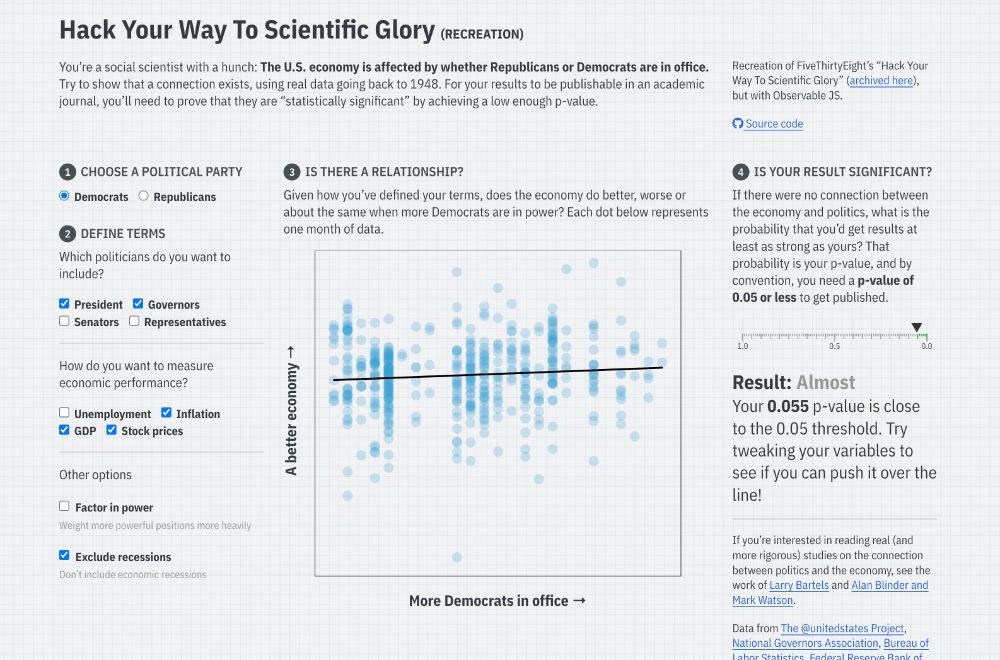Website: melodyyhuang.com
With current technology, it is impossible to tell whether survey respondents are real or bots. Among other things, makes it easy for bad actors to manipulate outcomes. No good news here for the future of online-based survey research

With current technology, it is impossible to tell whether survey respondents are real or bots. Among other things, makes it easy for bad actors to manipulate outcomes. No good news here for the future of online-based survey research
www.pnas.org/doi/10.1073/...

www.pnas.org/doi/10.1073/...


New preprint w/ @melodyyhuang.bsky.social tries to do just that. Here's one cool figure—we're able to visualize bias of 3 estimators on the same plot

New preprint w/ @melodyyhuang.bsky.social tries to do just that. Here's one cool figure—we're able to visualize bias of 3 estimators on the same plot
arxiv.org/abs/2507.23743

arxiv.org/abs/2507.23743
![4-panel comic. (1) [Person 1 with ponytail flanked by person with short hair and another person speaking into microphone at podium] PERSON 1: In the early 2010s, researchers found that many major scientific results couldn’t be reproduced. (2) PERSON 1: Over a decade into the replication crisis, we wanted to see if today’s studies have become more robust. (3) PERSON 1: Unfortunately, our replication analysis has found exactly the same problems that those 2010s researchers did. (4) [newspaper with image of speakers from previous panels] Headline: Replication Crisis Solved](https://cdn.bsky.app/img/feed_thumbnail/plain/did:plc:cz73r7iyiqn26upot4jtjdhk/bafkreibwuu57ullc7vacjyno6c5z3gtyakkg2qub6cn3dbbjdpn2kaowmi@jpeg)
'bases' provides a number of basis expansions that you can use inside any modeling formula. This means you can fit nonparametric regressions with lm() or glmnet() easily!
Bases includes random Fourier features, approximate BART, and more!

'bases' provides a number of basis expansions that you can use inside any modeling formula. This means you can fit nonparametric regressions with lm() or glmnet() easily!
Bases includes random Fourier features, approximate BART, and more!
So I made my own with #rstats and Observable and #QuartoPub ! stats.andrewheiss.com/hack-your-way/

So I made my own with #rstats and Observable and #QuartoPub ! stats.andrewheiss.com/hack-your-way/

arxiv.org/abs/2412.11136

arxiv.org/abs/2412.11136
tobin.yale.edu/opportunitie...
tobin.yale.edu/opportunitie...


![Comic. [Graph with x axis for City Size and y axis for Tastiness of “<City>-Style Pizza”. An arrow points to bottom left corner, labeled Towns with bored restaurant owners who have come up with a fun prank to play on visitors. A shaded area covers the length of the y-axis on the left, then narrows toward the right, with the bottom curving upwards toward the right. Arrows within the region point in all different directions labeled Various controversial regional specialties. An arrow points to the upper right corner of this shaded region with label New York up here somewhere.]](https://cdn.bsky.app/img/feed_thumbnail/plain/did:plc:cz73r7iyiqn26upot4jtjdhk/bafkreia57ty6octmfwajfvgo5hh3jdvouoo47fht6wiz25lh7ugncrnyqq@jpeg)